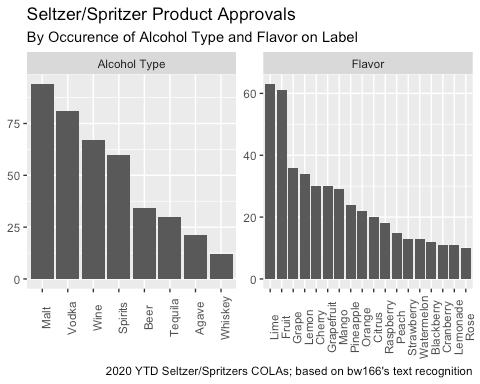The past year has been chaotic. Between pandemic-related shutdowns and wildfires in California, the beverage alcohol industry has faced a gamut of challenges across all three tiers. With this article, we wanted to look at the effect on the supplier tier superficially. With many smaller suppliers dependent upon on-premise sales (through tasting rooms, brewpubs, and distilleries), it’s logical to surmise the industry would see increased supplier closures similar to the results in the on-premise.
Using bw166’s Label Inquiry tool, we’ve compiled data on how many suppliers have submitted COLAs to the TTB from 2016 through 2020. This data allows us to identify suppliers that have consistently filed COLAs year over year, when suppliers have first filed COLAs, and identify suppliers that filed previously but not in the current term. While there are limits to this dataset (i.e., not all beer products require a TTB COLA), the consistent measurement over time allows for a reasonable degree of confidence in the results.
Beer –

- From 2016 through 2019, the Beer industry consistently showed an increasing number of suppliers – from 1,650 in January 2016 to 2,430 in January 2020. However, 2020 is the first year of declines – falling to 2,250 in December 2020. This decline of -9% in breweries is likely understated (as using a rolling 12-month figure (to smooth seasonality) doesn’t reflect nearer-term closures.

- New beer suppliers spike in early 2018 and have declined since, with a more pronounced decline in 2020. In January 2020, there were 800 new suppliers versus only 630 in December 2020 (this was roughly the level of new entrants in 2016).

- Overall, the number of lost beer suppliers continues its upwards trajectory. Interestingly, we have not seen a significant increase in closures during 2020 (though this may again be affected by looking at 12 months of data).
Spirits –

- The Spirits industry has shown a significant increase in supplier count since 2016 – rising from 1,000 in January 2016 to 1,660 in December 2020. Through 2020, the number of suppliers has continued to increase (albeit with a slight decline from 1,700 in November 2020 to close out the year – though this may just be volatility in measurement than reflective of significant changes)

- The number of new spirits suppliers steadily increased between 2016 and 2020. During 2020, the number of new suppliers peaked at 660 in August and then fell to 630 in December – still near the high point historically and above the 600 new suppliers in January 2020.

- Lost spirits suppliers have been steadily rising from 2016 through 2019 – starting at 250 in January 2016 and ending at 503 in December 2019. This trend has been reasonably stable throughout 2020 – staying just above or below that 500 supplier count (ranging between 470 and 520 during any particular month).
Wine –

- Wine suppliers saw a steady increase from 2016 through 2019 (from 4,400 in January 2016 to 4,760 in December 2020), followed by a significant increase in early 2020 and then a decline to end the year in December. The probable explanation for these results, particularly the disconnected data in 2019, is attributable to the government shutdown in January 2019, which altered COLA approval patterns.

- New wine suppliers showed a steady though slight positive increase from 2016 through 2019 – starting at 1,480 in January 2016 and ending at 1,580 in December 2019. The government shutdown explains the rapid rise in January 2020 (1,770 new suppliers). This shift also explains the apparent drop in new suppliers through 2020, ending at 1,580 in December 2020 – exactly in line with the historically stable numbers.

- While lost wine supplier counts increased in 2020 (from 1,400 in January to 1,610 in December), these numbers are reasonably in range of historical results. The other unexplained facet is the potential effect of the California wildfires. With lost crops, a natural consequence would be delays or cancellations in new products, which may also explain this rise in lost suppliers.
Closing Thoughts
- Overall, there does not seem to be a significant acceleration of closures in the supplier tier. Instead, the current data suggest a continuation of existing trends in terms of closures.
- The more considerable impact in the supplier tier seems to present itself in the deceleration of new suppliers. Given economic and COVID-related uncertainty, it is logical that individuals would be hesitant to start a new venture.
- If you found this article helpful or informative (or if not), send us a note at admin@bw166.com. If there’s enough interest, we can look at publishing an updated analysis in the future.
For more granular insights and data about Product Approvals, subscribe to the Label Inquiry by bw166 or visit our website at www.bw166.com.












